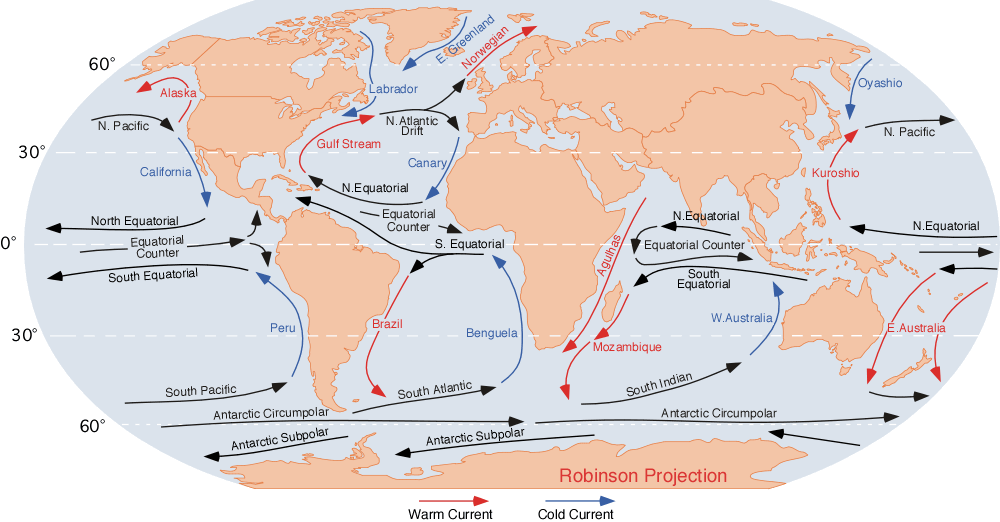-
18 Jul 2024
GS Paper 1
Geography
Day 10: What factors contribute to the formation of ocean currents? How do these currents affect regional climates, fishing industries, and navigation? (250 words)
Approach:
- Define ocean currents and their importance in the Earth's climate system.
- Briefly outline the main factors contributing to their formation .
- Mention the aspects of regional climate, fishing industries, and navigation as areas affected by ocean currents.
- Conclude suitably.
Introduction:
Ocean currents are continuous, directed movements of seawater generated by various factors. These currents play a crucial role in regulating the Earth's climate, supporting marine ecosystems, and facilitating maritime navigation. Understanding their formation and impact is essential for comprehending their influence on regional climates, fishing industries, and navigation.
Body :
Factors Contributing to the Formation of Ocean Currents
- Wind Patterns : Wind-driven currents occur when surface winds blow over the ocean, creating friction that moves the water. The primary winds include trade winds (easterlies), westerlies, and polar easterlies.
- Examples: The Trade Winds drive the equatorial currents, such as the North Equatorial Current in the Atlantic Ocean, while the Westerlies contribute to the movement of currents like the Kuroshio Current in the Pacific.
- Earth's Rotation (Coriolis Effect) : The Coriolis effect, resulting from the Earth's rotation, deflects moving water to the right in the Northern Hemisphere and to the left in the Southern Hemisphere, shaping the paths of ocean currents.
- Examples: This deflection leads to the formation of gyres, such as the North Atlantic Gyre and South Pacific Gyre, which are large systems of rotating ocean currents.
- Temperature and Salinity Differences (Thermohaline Circulation) : Thermohaline circulation, or the global conveyor belt, is driven by differences in water density caused by variations in temperature and salinity. Cold, salty water sinks in polar regions, creating a deep ocean current that moves around the globe.
- Examples: The Atlantic Meridional Overturning Circulation (AMOC) is a key component of this global system, influencing climate patterns by redistributing heat.
- Earth's Topography : The underwater topography, including ridges, mountains, and basins, affects the direction and speed of ocean currents by creating barriers or channels.
- Examples: The Mid-Atlantic Ridge influences the flow of the North Atlantic Current, while the Indonesian Throughflow affects the distribution of currents in the Indian Ocean.
- E. Tides : Tidal forces, generated by the gravitational pull of the moon and sun, create tidal currents that fluctuate with the rise and fall of tides.
- Examples: Tidal currents are prominent in coastal areas such as the Bay of Fundy in Canada, where extreme tidal ranges generate strong currents.
Effects of Ocean Currents
- Regional Climate : Ocean currents regulate coastal climates by modifying air temperatures and precipitation patterns. Warm currents increase temperatures, while cold currents cool them.
- Examples: The Gulf Stream warms the climate of Western Europe, leading to milder winters. Conversely, the California Current cools the climate of the West Coast of North America, resulting in cooler temperatures and reduced precipitation.
- Fishing Industries : Currents affect marine ecosystems by transporting nutrients and influencing fish migration patterns. Upwelling currents, in particular, bring nutrient-rich waters to the surface, supporting high productivity and fish populations.
- Examples: The Peruvian (Humboldt) Current is renowned for its upwelling, supporting one of the world's most productive fisheries. The Benguela Current off the coast of Namibia also supports a significant fishing industry due to its nutrient-rich waters.
- Navigation : Knowledge of ocean currents is vital for navigation, affecting fuel consumption, travel times, and route planning. Mariners use currents to optimize their voyages and reduce costs.
- Examples: The use of the Gulf Stream has historically enabled faster transatlantic crossings. Modern navigators account for currents like the Antarctic Circumpolar Current when planning routes to avoid adverse conditions.
Conclusion
Ocean currents are intricately linked with global environmental and economic systems. They regulate climate, support marine ecosystems, and influence carbon storage, while also impacting fishing industries, maritime navigation, and energy production. Understanding and managing these currents is essential for addressing climate change, sustaining marine resources, and optimizing economic activities. The interconnectedness of ocean currents with these systems highlights their significance in shaping the Earth's environmental and economic landscape.






